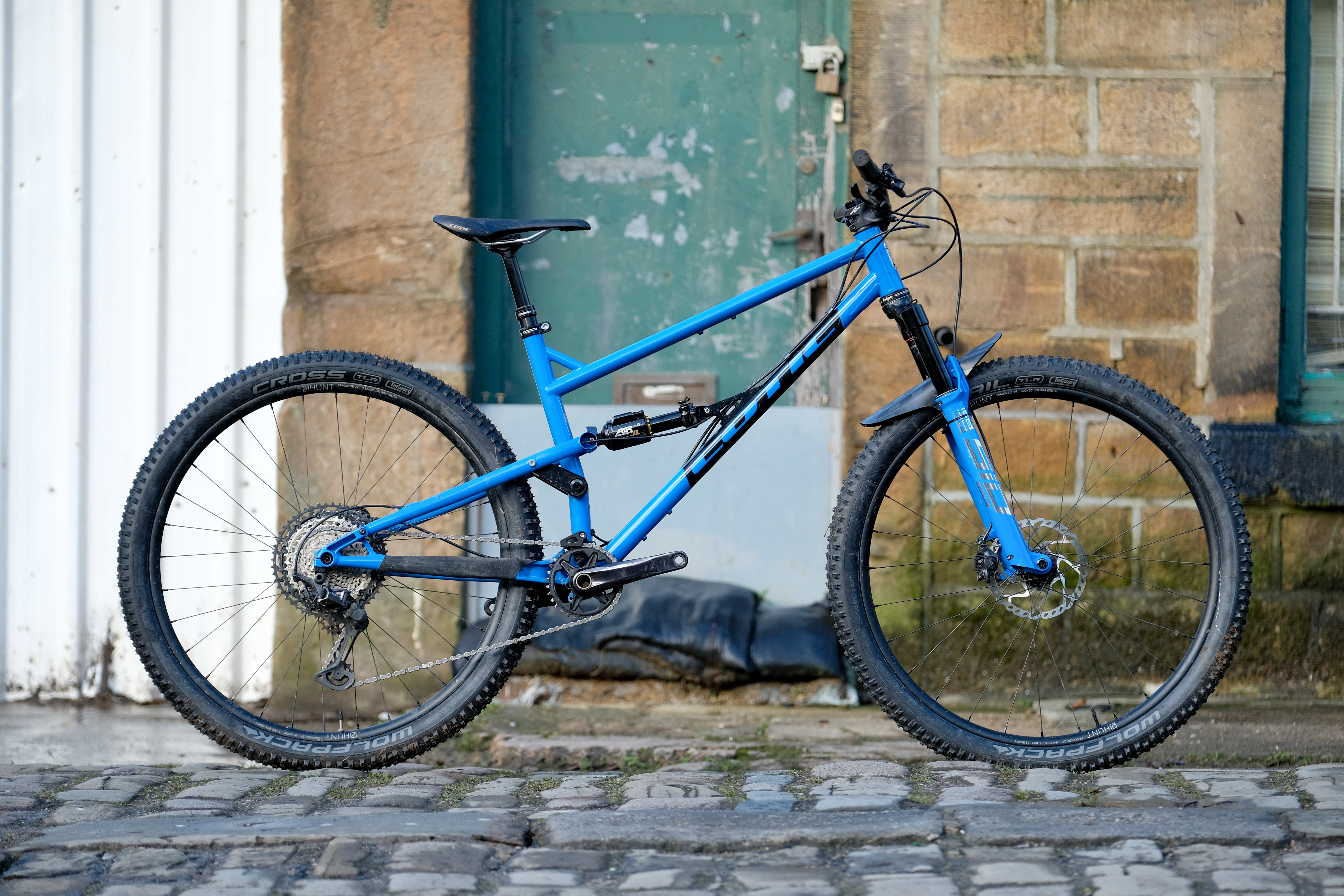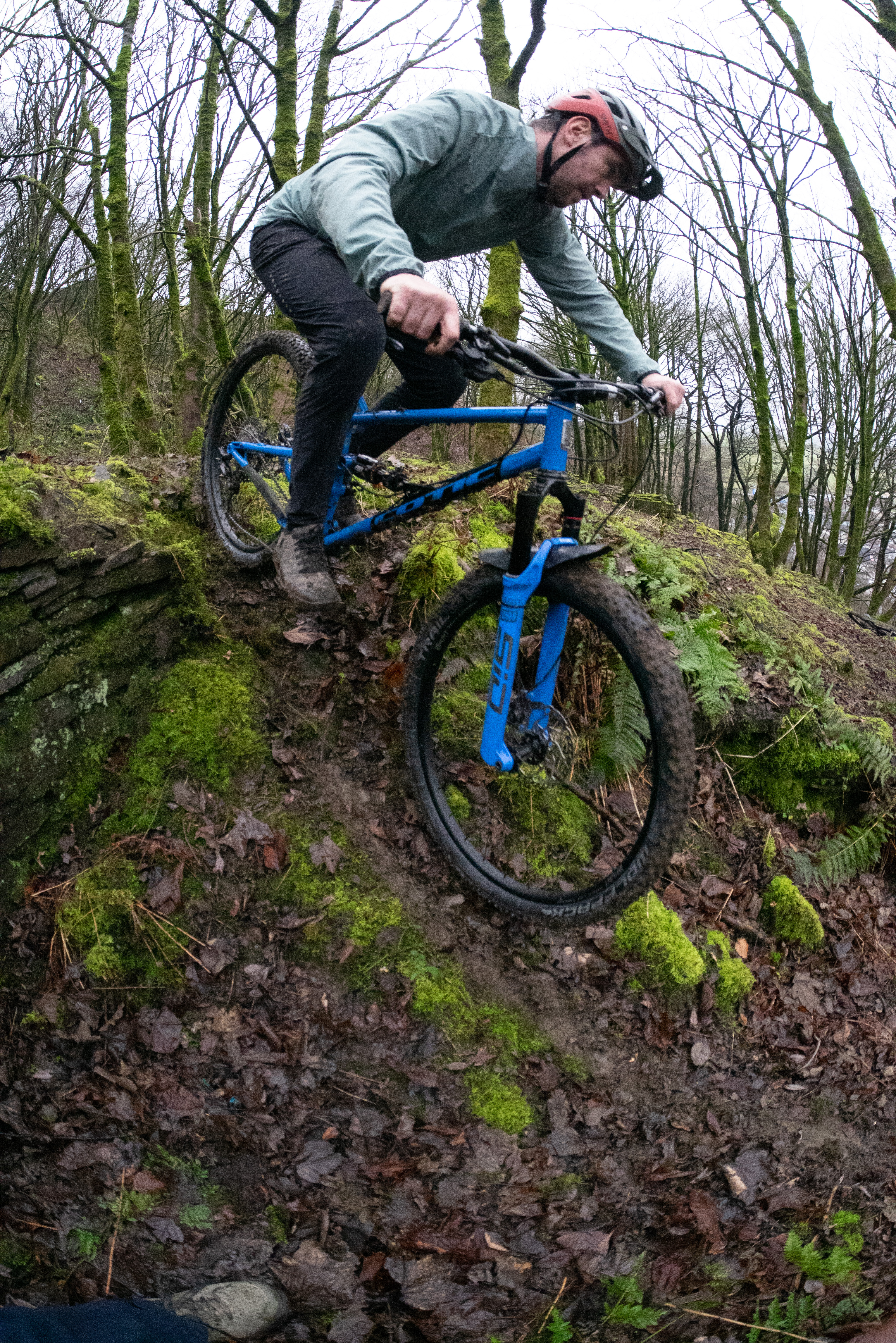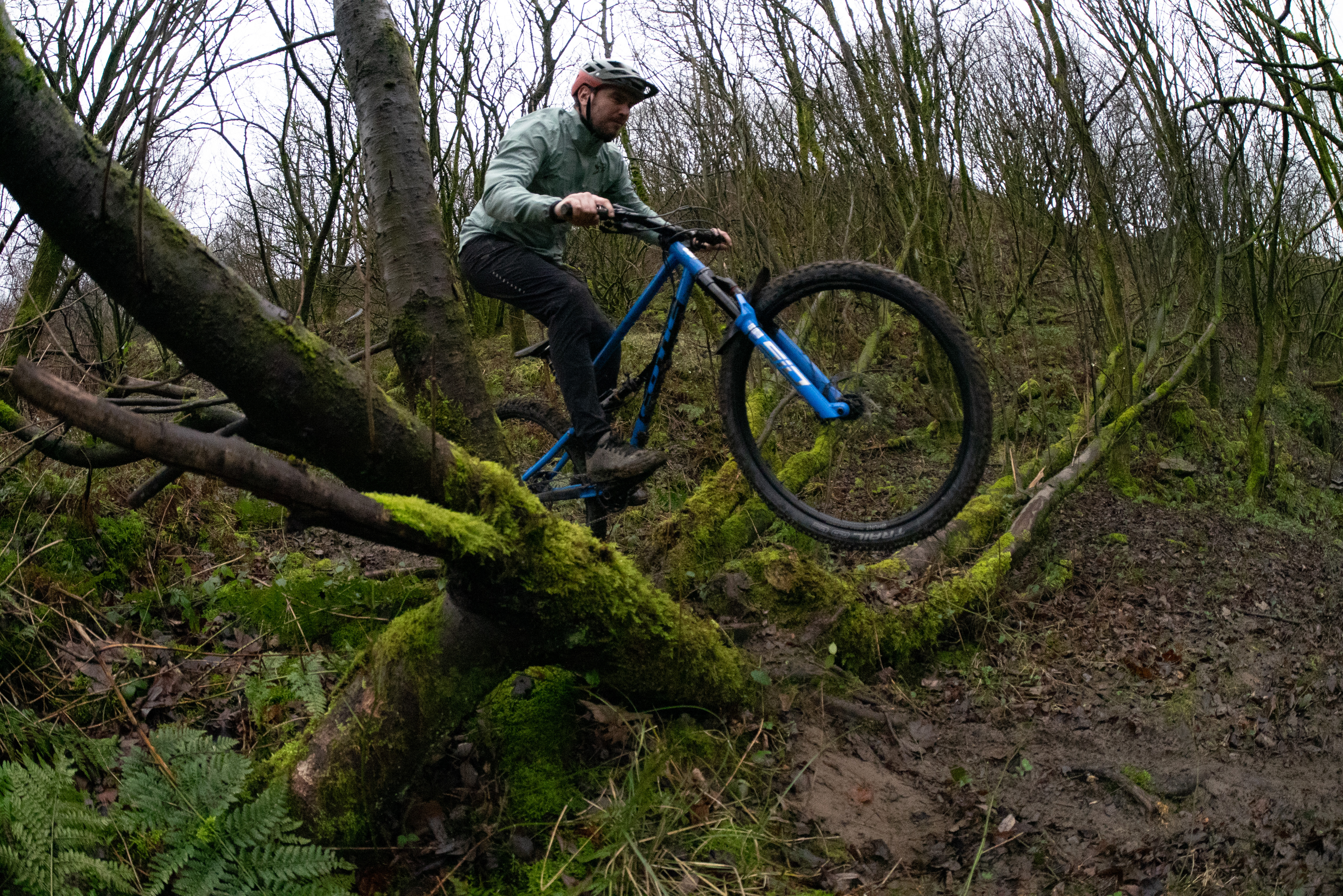The Cotic FlareMAX Gen4 is reviewed in Issue 142 Bike Test – The Big Short.

Gen4 means fourth generation. This is the fourth iteration of Cotic’s shorter travel (125mm) full suspension bike. As with most Cotic bikes, although there are preset complete builds available, a significant number of people buy a ‘rolling chassis’ (fork, shock, wheels, headset) with a view to completing the build with their own stuff. The FlareMAX can be built up in a few different ways, spanning 120mm forked down-country duties through to 140mm forked trail trucker.
The Cotic FlareMAX we tested, as you can see, is very much at the down-country end of the spectrum. A RockShox SID Ultimate fork offers a punchy 120mm of travel and those Wolfpack tyres indicate a concern for rolling resistance and gram counting.
Having said that, the heart of the bike is the frame and rear shock. The frame still sports Cotic’s progressively minded long-reach Longshot geometry numbers. The rear shock is the excellent Cane Creek DBAir IL. The combination of Longshot and Cane Creek DB is absolutely the most significant aspect of this, or indeed any, FlareMAX build.
The Bike
Having the least amount of fork travel advised for a FlareMAX, this test bike is steeper angled, but crucially is also lower slung and longer in reach than its longer fork builds. The head angle is 66°. This number is steep for a trail bike, yet still considered slack for a cross-country bike. Down-country then. The reach and BB height numbers tell a bigger picture, however. The reach is a generous 490mm on this Large and the BB height is a lowly 330mm.



It’s worth highlighting Cotic’s use of the 44mm head tube standard. This is simply the best standard there is and I wish everyone would use it. You can do anything you want with it. Run internal cups, run external cups, run a combo of both. Essentially you can fine-tweak the stack and front-end ride height of the bike. The head tube length is nominally 120mm, but you can run it effectively as 130mm (with an external lower cup, as here). And for the geo tweakers amongst us, it accepts whatever angle-adjust headset you wish to use. Down-country bike with a 64° head angle anyone?
Anyway, this here long-but-steep test bike reminds us of the original Forward Geometry Mondrakers – not especially slack, but really long and low. It’s a fun combination that works well with the right rider or mindset. The seat angle is also decently steep at 76° which helps when climbing, but also prevents the bike from feeling overly stretched out when cruising along in the saddle. The effective top tube is lengthy (644mm) but the dinky 35mm stem length keeps those grips in range nicely.




The frame is made from steel (the chainstays are aluminium). What effect this has on the ride of the bike is often confusing to people. The effect it has on the look of the bike is obvious. It looks rad. The use of steel arguably doesn’t have much to do with the vertical compliance of the bike (it’s a suspension bike anyway), but using steel for those lengthy top and downtubes will have an effect laterally. Take a closer look at the top tube and you’ll see that it is not round: it’s laterally ovalised. This is to control just how much lateral give it er, gives.
Compared to Gen3, the new Cotic FlareMAX has a slightly repositioned suspension arrangement. The pivot on the seat tube is now lower. This has principally been done to improve compatibility with longer dropper posts. It will also have an effect on the suspension in terms of reduced anti-squat and general leverage ratio. Other changes include a move to metric shock dimensions and improved tyre clearance around the chain stays.




Although it’s less vital to dig into the details of build kit on bikes like the build-your-own FlareMAX, the bits bolted on to our test bike clearly have an effect on the overall ride and vibe of the bike. In many ways, the outliers here are the SID fork and the Wolfpack tyres. They are overtly wannabe down-country, borderline cross-country in fact. The rest of the FlareMAX build is fairly standard trail bike stuff. Hunt Trail Wide wheels. Shimano XT drivetrain and brakes. X-Fusion Manic dropper, in rather modest 150mm guise. The saddle, bars, stem and grips are all Cotic in-house items. And that Cane Creek DB Air IL rear shock overrules everything.
This particular Cotic FlareMAX looks a bit like a trail wolf in cross-country sheep’s clothing. Let’s see how it behaved out on the trails…
The Ride
I’ve spent a long time on 130mm and 140mm fork FlareMAX builds so it was very interesting to sling a leg over a 120mm fork one at last. The first thing to say is that the RockShox SID is an amazing fork. There are much poorer performing 140mm forks out there! It may only have 120mm to offer, but it dishes it out in an impressively controlled and stout fashion.
Truth be told, I didn’t really feel like the amount of fork travel was the most significant thing here. The lower and longer stance of the bike was much more noticeable when comparing to longer fork travel FlareMAX builds. As a long-term All Mountain Enduro Wannabe it kinda pains me to admit that this longer and lower FlareMAX is a ‘better’ bike than the higher and shorter 140mm version.
When it comes to truly smashing down trails, even 140mm isn’t really enough (dang it). If you’re running less than a 160mm fork, you may as well go the whole hog down(country) to 120mm. This is the key thing here. The lower BB, steeper seat angle and slightly longer reach all combine to make this FlareMAX a really nice place to be. Much nicer than 20mm extra of fork bounce gives you.

The head angle may raise enduro eyebrows but, on the trail, the bike’s low slung length and generous standover make it able to get down virtually anything. Personally, although impressive for what they are, I wouldn’t opt to run the Wolfpack tyres. They are the weak link, considering what this bike can tear down. Obviously, we did slap on some Maxxis Minion DHR II tyres front and rear for a portion of the test period to test (and prove) this.
I also think Large bikes with long reaches should come with higher-than-25mm riser bars. But that’s possibly just me. Continuing the prissy journo tack, I’d prefer 165mm cranks fitted on bikes this low slung.
On to the main thing. The frame and rear shock. Can I just get away with saying ‘they are well good’? No? Okay then. The Cane Creek DBAir IL is very possibly the best air shock currently available for regular trail riders. Fantastically fluid feeling without being mushy. Loads of support deeper into the stroke. Genuinely useful range of adjustment. And the climb mode is by far the best incarnation of anyone’s. It reduces rebound as well as compression and feels much less choppy and stuttery as a result.
And you will probably need the climb switch. The FlareMAX is not ashamed of its suspension. It moves. If you’re someone who gets annoyed with bob and/or you’re not someone prepared to spend time setting up a shock and/or unwilling to use a climb switch, look elsewhere.

For a company that originally just did hardtails, Cotic are ‘very suspension’. Cotic’s full suspension bikes are about grip and capability. And despite the iconic blue SID up front and the balding tyres, this Cotic FlareMAX is still ‘very suspension’. This may lose you some places on the Strava Leaderboard of your local fire road climb but… and? It’s not a climber’s bike. The FlareMAX is a bike handler’s bike.
It’s about doing a lot with not very much. It’s about rider and machine and dirt getting to know each other and enjoying the interaction. It’s about not being in fear and holding on for dear life while being beaten up by terrain. With 120/125mm of eager, yet well-controlled, suspension and a frame that conforms to cambers and doesn’t get deflected when carving rocky turns, it’s just great fun.
Niggles? Aside from the aforementioned tyre, handlebar and crank moans, I didn’t think about the brakes and gears once. Great stuff. The saddle was overly round and small for my posterior. The biggest annoyance was having a dropper post with only 150mm travel (I did install a 170mm dropper for the latter part of testing, so it’s not a death knell issue).
Overall
Shorter travel bikes can be a tricky sell. I personally wouldn’t have one as my one and only bike. They’re just too limited when it comes to day trips to the big terrain. Or when riding unknown trails on sight. But if you want a bike for ragging around trails that you know well – or can guarantee an area isn’t going to throw boulder fields at you at 20mph – then the FlareMAX is a blast.
This is not a stiff and efficient mountain bike in the traditional Lycra cross-country sense. It’s way better than that. It doesn’t ride like a hardtail. It doesn’t just give up a bit of off/on suspension when it absolutely has to. It has a rare combination of stability combined with whip-smart handling and traction tracking.
Is it worth the small brand price premium? Well, currently there’s no choice. Until a big brand offers a short travel bike with decent geometry made out of steel (i.e. never), the Cotic FlareMAX will remain a delectable outlier.
Cotic FlareMAX Gen4 Specification
- Frame // Reynolds 853 with 6066-T6 aluminium chainstays, 125mm
- Shock // Cane Creek DB IL Air, 200x50mm
- Fork // RockShox SID Ultimate, 120mm, 44mm offset
- Wheels // HUNT Trail Wide
- Front Tyre // Wolfpack Trail 29×2.4
- Rear Tyre // Wolfpack Cross 29×2.4
- Chainset // Shimano Deore XT, 170mm, 32T
- Drivetrain // Shimano Deore XT M8100 12-speed
- Brakes // Shimano Deore XT M8120, 180/180mm rotors
- Stem // Cotic SHORTERSTEM 35mm
- Bars // Cotic Calver, 780x25mm
- Grips // Cotic Black Lock-on
- Seatpost // X-Fusion Manic dropper 150mm
- Saddle // Cotic Black
- BB // Shimano, threaded
- Size Tested // L
- Sizes Available // S, M, L, XL
- Weight // 13.8kg
Geometry for our size L test bike:
- Head angle // 66°
- Effective seat angle // 76°
- Seat tube length // 460mm
- Head tube length // 120mm
- Chainstay // 448mm
- Wheelbase // 1,251mm
- Effective top tube // 644mm
- BB height // 330mm
- Reach // 490mm





